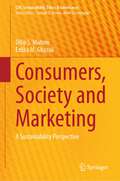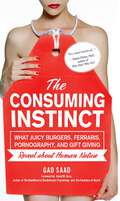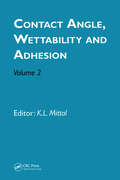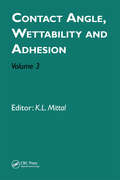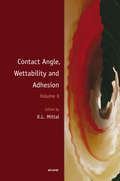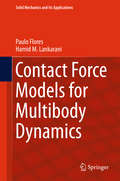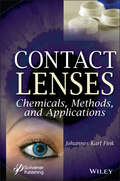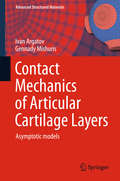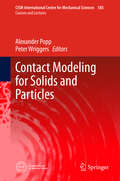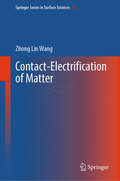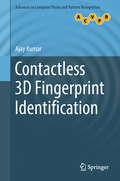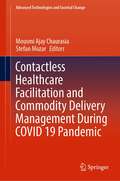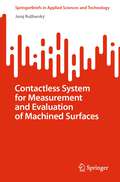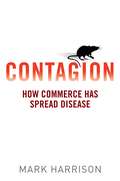- Table View
- List View
Consumers, Society and Marketing: A Sustainability Perspective (CSR, Sustainability, Ethics & Governance)
by Dilip S. Mutum Ezlika M. GhazaliEnvironment and social responsibility are paramount for any modern business strategy, and the field of marketing is adapting itself to the new focus on sustainability. The study of the interface between consumers, society, and marketing is crucial for understanding the complex interactions between individuals and the products and services they consume and the resulting implications. In this book, the authors delve into the latest research and theories on the subject, providing insight into the various factors that shape consumer behavior and the broader impacts of marketing on society. Whether you are a student, professional, or simply curious about the topic, this book will provide a valuable resource for your learning and exploration. Instead of treating ethical foundations and critical marketing perspectives separately, this book merges them and takes a broader sustainability perspective. It examines the various ways in which businesses are incorporating sustainability into their marketing strategies, and the impact these efforts are having on consumers, the economy, and the planet. Topics covered in this book include: Evolution of marketing thoughtCritique of marketingSustainable marketingSocial marketingEvolving consumer representations and roles, and many more
Consuming Citizens: Countercultural Bodies in Twentieth-Century Mexico (SUNY series, Genders in the Global South)
by Iván Eusebio Aguirre DarancouExplores twentieth-century Mexican counterculture through the lens of pleasure, body autonomy, and music and film undergrounds.Consuming Citizens offers a fresh conception of twentieth-century Mexican cultural production by critically tracing the underside of mestizo modernity. Examining a diverse corpus that includes poetry, song, avant-garde film, and more from the 1920s to '80s, the volume uses queer, feminist, and psychedelic theories to understand counterculture-and especially different acts of consumption-as a way of creating culture and alternative social structures. Practices of consuming media, sex, and drugs become means of generating community among subjects who have been marginalized by the nominally inclusive mestizo nation. Consuming Citizens thus rethinks nationalism, citizenship, and society in relation to, and as creations of, countercultural bodies.
Consuming Instinct: What Juicy Burgers, Ferraris, Pornography, and Gift Giving Reveal About Human Nature
by Gad SaadIn this highly informative and entertaining book, the founder of the vibrant new field of evolutionary consumption illuminates the relevance of our biological heritage to our daily lives as consumers. While culture is important, the author shows that innate evolutionary forces deeply influence the foods we eat, the gifts we offer, the cosmetics and clothing styles we choose to make ourselves more attractive to potential mates, and even the cultural products that stimulate our imaginations (such as art, music, and religion). The book demonstrates that most acts of consumption can be mapped onto four key Darwinian drives-namely, survival (we prefer foods high in calories); reproduction (we use products as sexual signals); kin selection (we naturally exchange gifts with family members); and reciprocal altruism (we enjoy offering gifts to close friends). The author further highlights the analogous behaviors that exist between human consumers and a wide range of animals. For anyone interested in the biological basis of human behavior or simply in what makes consumers tick-marketing professionals, advertisers, psychology mavens, and consumers themselves-this is a fascinating read.
Consumption, Sustainability and Everyday Life (Consumption and Public Life)
by Kenneth Bo Nielsen Arve HansenThis open access book seeks to understand why we consume as we do, how consumption changes, and why we keep consuming more and more, despite the visible damage we are doing to the planet. The chapters cover both the stubbornness of unsustainable consumption patterns in affluent societies and the drivers of rapidly increasing consumption in emerging economies. They focus on consumption patterns with the largest environmental footprints, including energy, housing, and mobility and engage in sophisticated ways with the theoretical frontiers of the field of consumption research, in particular on the ‘practice turn’ that has come to dominate the field in recent decades. This book maps out what we know about consumption, questions what we take for granted, and points us in new directions for better understanding—and changing—unsustainable consumption patterns.
Contact Angle, Wettability and Adhesion, Volume 2
by K. L. MittalThis volume documents the proceedings of the Second International Symposium on Contact Angle, Wettability and Adhesion held in Newark, NJ, June 21-23, 2000. Since the first symposium, held in 1992, there had been tremendous research activity on many ramifications of wettability phenomena.This volume contains a total of 33 papers, which were all pro
Contact Angle, Wettability and Adhesion, Volume 3
by K. L. MittalThis volume chronicles the proceedings of the Third International Symposium on Contact Angle, Wettability and Adhesion held in Providence, Rhode Island, May 20a 23, 2002. This symposium was held to provide a forum to update and consolidate the research activity on this topic. The world of wettability is very wide as it plays an extremely important
Contact Angle, Wettability and Adhesion, Volume 6
by K. L. MittalThe topic of wettability (measured in terms of contact angle) is of tremendous interest from both fundamental and applied points of view, Wettability plays an essential role in many industrial processes, so an understanding of factors dictating wettability and how to modulate it is of paramount importance. In the last years there has been an explos
Contact Force Models for Multibody Dynamics (Solid Mechanics and Its Applications #226)
by Paulo Flores Hamid M. LankaraniThis book analyzes severalcompliant contact force models within the context of multibody dynamics, whilealso revisiting the main issues associated with fundamental contact mechanics. In particular, it presents various contact force models, from linear tononlinear, from purely elastic to dissipative, and describes their parameters. Addressing the different numerical methods and algorithms for contact problemsin multibody systems, the book describes the gross motion of multibody systemsby using a two-dimensional formulation based on the absolute coordinates andemploys different contact models to represent contact-impact events. Resultsfor selected planar multibody mechanical systems are presented and utilized todiscuss the main assumptions and procedures adopted throughout this work. Thematerial provided here indicates that the prediction of the dynamic behavior ofmechanical systems involving contact-impact strongly depends on the choice ofcontact force model. In short, the book provides a comprehensive resource forthe multibody dynamics community and beyond on modeling contact forces and thedynamics of mechanical systems undergoing contact-impact events.
Contact Lenses: Chemicals, Methods, and Applications
by Johannes Karl FinkCONTACT LENSES The book focuses on the chemistry and properties of contact lenses and their fabrication methods. With research & development continuing in the field, this comprehensive book takes a look at the last 10 years in terms of new materials, chemistry methods, applications, and fabrication techniques. New applications include drug delivery, lenses for augmented reality, electronic contact lenses, and wearable smart contact lenses. In addition, the book discusses simulation methods for contact lenses, such as ocular topography parameters, gas permeable lenses, and computerized videokeratography. On the fabrication front, several common fabrication methods for contact lenses are detailed, including the computer-aided contact lens design, methods for the fabrication of colored contact lenses, and the fabrication of decentered contact lenses. Special processes are reviewed, including, mold processes, reactive ion etching, electrospinning, and others. Also discussed are the properties of contact lenses and methods for the measurement. Many of the standard methods are discussed, but other issues are taken up too including a discussion on the assessment of cytotoxic effects, the Schirmer tear test, and others. The book concludes with a chapter detailing the possible medical problems related to contact lenses and how to avoid them. These include eye diseases, allergic and toxic reactions, as well as methods for medical treatment such as disinfection agents. Audience The book will be used by chemists, polymer scientists, ophthalmologists, engineers in the contact lens industry as well as polymer industries.
Contact Lenses: Research, Industry, and User Perspectives (Series in BioEngineering)
by Nadia Adrus Muhammad Aqil bin Mohd Farizal Jamarosliza Jamaluddin Fatria Syaimima bin Syaiful Azim Farahin M. Mizi Saravanan Nanda Kumar James Jeyadeva GovindasamyThis book covers contact lenses from its origin and history, integrated with research, industrial, and consumer perspectives. Readers will be able to acquire knowledge on the origin of contact lenses up to the evolution of basis material used for contact lens manufacturing. In terms of research perspectives, major material properties of contact lens, together with the compilation of studies for contact lens properties that had been done so far, will be served in this book, which is beneficial to the researchers. For industrial perspectives, commercialization of contact lenses will be discussed, including the steps in manufacturing contact lenses and other aspects in the industry including the latest challenges, development, and improvement in contact lens. Moreover, this book gives exposure on the type of contact lens that is available in the market and some useful guidelines for contact lens users.
Contact Mechanics of Articular Cartilage Layers: Asymptotic Models (Advanced Structured Materials #50)
by Gennady Mishuris Ivan ArgatovThis book presents a comprehensive and unifying approach to articular contact mechanics with an emphasis on frictionless contact interaction of thin cartilage layers. The first part of the book (Chapters 1-4) reviews the results of asymptotic analysis of the deformational behavior of thin elastic and viscoelastic layers. A comprehensive review of the literature is combined with the authors' original contributions. The compressible and incompressible cases are treated separately with a focus on exact solutions for asymptotic models of frictionless contact for thin transversely isotropic layers bonded to rigid substrates shaped like elliptic paraboloids. The second part (Chapters 5, 6, and 7) deals with the non-axisymmetric contact of thin transversely isotropic biphasic layers and presents the asymptotic modelling methodology for tibio-femoral contact. The third part of the book consists of Chapter 8, which covers contact problems for thin bonded inhomogeneous transversely isotropic elastic layers and Chapter 9, which addresses various perturbational aspects in contact problems and introduces the sensitivity of articular contact mechanics. This book is intended for advanced undergraduate and graduate students, researchers in the area of biomechanics, and engineers interested and involved in the analysis and design of thin-layer structures.
Contact Modeling for Solids and Particles (CISM International Centre for Mechanical Sciences #585)
by Peter Wriggers Alexander PoppThe book conveys modern techniques and the latest state-of-the-art with regard to the most fundamental aspects of computational contact mechanics. However, since contact can readily be interpreted as a special type of interface problem, it seems advisable not to isolate contact mechanics, but rather to address it in the context of a broader class of problems denoted as computational interface mechanics. The book gives a clear understanding of the underlying physics of interfaces, and a comprehensive insight into the current state-of-the-art and selected cutting-edge research directions in the computational treatment of interface effects. It focuses on the modeling of friction, wear, lubrication, cohesive interfaces, grain boundaries, phase boundaries, fracture, thermo-mechanics and particulate contact (e.g. granular media). Also the most important computational aspects are addressed, including discretization techniques for finite deformations, solution algorithms for single- and multi-processor computing environments, multi-scale approaches, discrete element models and multi-physics problems including contact and interface constraints. Among the computational techniques covered in this book are finite element (FEM) and boundary element (BEM) methods, atomistic models, molecular dynamics (MD), discrete element methods (DEM), coupling approaches for multi-scale simulations, and tools for an efficient automated FEM code generation.
Contact Problems for Soft, Biological and Bioinspired Materials (Biologically-Inspired Systems #15)
by Feodor M. Borodich Xiaoqing JinThis book contains contributions from leading researchers in biomechanics, nanomechanics, tribology, contact mechanics, materials science and applications on various experimental techniques including atomic force microscopy (AFM) for studying soft, biomimetic and biological materials and objects. Biologists, physicists, researchers applying methods of contact mechanics and researchers testing materials using indentation techniques along with many other applied scientists will find this book a useful addition to their libraries. Moreover, several reviews in this book are written as introductions to several important and rather sophisticated research areas such as depth-sensing indentation, studying of biological cells by AFM probes, mechanics of adhesive contact and contact between viscoelastic (hereditary elastic) solids. The book containing new theoretical models, results of experimental studies and numerical simulations, along with reviews of above mentioned areas of contact mechanics in application to biological systems, would be beneficial for researchers in many areas of biology, medicine, engineering, mechanics and biomimetics.
Contact mechanics
by K. L. JohnsonThis book describes the stresses and deformations of solid bodies in contact with each other, along curved surfaces that touch initially at a point of contact or along a line. Examples are a railroad track and the wheels running on it, or a pair of meshed gear teeth. The book commences with the development of the theory since the problem was first described in 1882. There is also a discussion of the influence of friction and the topographical roughness of surfaces. An important feature of the book is the treatment of plastic and viscoelastic bodies, and an appreciable section of the book discusses bodies in sliding or rolling contact. The mathematical treatment assumes that users of the book are graduates in engineering; it is a book written by a distinguished engineer for other professionals and their graduate students.
Contact-Electrification of Matter (Springer Series in Surface Sciences #75)
by Zhong Lin WangThis book provides a comprehensive exploration of contact electrification across solid-solid, solid-liquid, and gas-solid interfaces. It looks into the underlying physics mechanisms, offering theoretical models and experimental methods to quantify and understand this ubiquitous yet complex phenomenon. Covering fundamental concepts such as triboelectricity, energy band models, and tribovoltaic effects, the book discusses the interactions and charge transfer processes that occur at various interfaces. Special attention is given to the role of material properties, electron transfer dynamics, and external factors such as surface roughness and environmental conditions. Each chapter builds upon foundational principles to provide a cohesive framework for understanding both the beneficial applications and potential drawbacks of contact electrification. In addition to theoretical insights, this book highlights cutting-edge technological applications related to contact-electrification, including triboelectric nanogenerators (TENGs), self-powered sensors, and contact-electro-catalysis. Practical implementations span fields such as sustainable energy harvesting, biomedical applications, environmental sensing, and advanced materials design. Written and edited by experts in the field, this book serves as an essential resource for researchers, engineers, and advanced students in materials science, physics, chemistry, and electrical engineering. With its rigorous treatment of the subject and focus on both foundational science and applied technologies, this book is poised to set the standard for research in contact electrification for years to come.
Contactless 3D Fingerprint Identification (Advances in Computer Vision and Pattern Recognition)
by Ajay KumarThis important text/reference presents the first dedicated review of techniques for contactless 3D fingerprint identification, including novel and previously unpublished research. The text provides a systematic introduction to 3D fingerprint identification, covering the latest advancements in contactless 2D and 3D sensing technologies, and detailed discussions on each key aspect in the development of an effective 3D fingerprint identification system.Topics and features: introduces the key concepts and trends in the acquisition and identification of fingerprint images, and a range of 3D fingerprint imaging techniques; proposes a low-cost method for online 3D fingerprint image acquisition, and an efficient 3D fingerprint imaging approach using coloured photometric stereo; describes pre-processing operations on point cloud 3D fingerprint data, and explains the specialized operations for reconstructing 3D fingerprints from live finger scans; examines the representation of minutiae in 3D space, providing details on recovering these features from point cloud data, and on matching such 3D minutiae templates; reviews various 3D fingerprint matching methods, including binary surface code-based approaches and a tetrahedron-based matching approach; discusses the uniqueness of 3D fingerprints, evaluating the benefits of employing 3D fingerprint identification over conventional 2D fingerprint techniques.This unique work is a must-read for all researchers seeking to make further advances in this area, towards the exciting opportunities afforded by contactless 3D fingerprint identification for improving the hygiene, user convenience, and matching accuracy of fingerprint biometric technologies.
Contactless Healthcare Facilitation and Commodity Delivery Management During COVID 19 Pandemic (Advanced Technologies and Societal Change)
by Stefan Mozar Mousmi Ajay ChaurasiaThis book offers concepts related to communication engineering principles to fight the current Covid situation, by developing contactless need-based solutions. COVID-19, a global pandemic makes us rethink how governments, organizations, and societies around the world can work with minimum or without physical contact. Technologies like artificial intelligence and big data are playing an essential role in responding to the COVID-19 pandemic. This book is a combination of chapters related to imaging and detective technologies used by the experts to fight the COVID-19 pandemic and a combination of interesting content covering the need of hour solutions generated through cutting edge technologies. In the absence of a proper medicine or vaccine, it is quite evident that nutrition plays an important role in the quick recovery of covid patients which must be very carefully planned with proper diagnostics. Data analysis and X-Ray/CT Image analysis by next-generation techniques like deep sensing, machine learning is interesting and useful for research and applied healthcare professionals. Research findings with a focus on diagnostics and reports generated through important data analysis in the book are quite useful and can be referred to by researchers and professionals working in the area of cutting-edge technologies against COVID 19.
Contactless System for Measurement and Evaluation of Machined Surfaces (SpringerBriefs in Applied Sciences and Technology)
by Juraj RužbarskýThis book presents a contactless system for the measurement and evaluation of selected characteristics of machined surfaces. It describes the design and construction of new equipment designed for contactless characterization of surface geometry working based on laser profilometry by triangulation principle. The book focuses on the quality assessment of surfaces produced by the technology of abrasive waterjet cutting (AWJ) and by laser. The author analyses the performed experiment of measurement of machined surfaces of samples of aluminum, stainless steel, and constructional steel using the contactless method with the LPM system and contact method using Mitutoyo SJ 400 surface roughness tester.
Contagio: La evolución de las pandemias
by David QuammenEL LIBRO INTERNACIONAL DE REFERENCIA DURANTE LA CUARENTENA. Desde hace años, para los expertos y cualquier persona informada, el estallido de la siguiente pandemia era una cuestión de tiempo, y su origen, evidente: un virus latente en animales que diera el salto al ser humano como el HIV que provocó el SIDA o el H1N1 que causó la gripe de 1918, el ébola, el SARS, el virus de Marburgo o el que produjo la gripe aviar. En esta obra de referencia internacional, David Quammen se sumerge en la historia reciente de esas enfermedades zoonóticas, y persigue su rastro en compañía de los mejores científicos del mundo en la selva centroafricana, las cuevas de China meridional o las azoteas de Bangladés, pero también en los sofisticados laboratorios cuyo personal investiga virus letales bajo las más altas medidas de seguridad. Aunque Contagio se lee como un thriller, repleto de incidentes, pistas e interrogantes, a la vista de la crisis desatada por la aparición del SARS-CoV-2, su lectura no solo resulta apasionante; es imprescindible. Reseñas:«Quammen es el mejor reportero del mundo natural.»Parul Sehgal, The New York Times «David Quammen es el mejor escritor de historia natural; sus libros impresionan por su precisión, su energía y su escritura brillante y evocativa.»David Barash, The Wall Streer Journal «El libro que me ayudó a entender la dinámica de lo que estaba pasando.»Paolo Giordano «Deslumbrante Quammen: desvela lo que nos hace vivir y lo que nos mata con pasión, humor y conocimiento.»Daniel Arjona, El confidencial «Un libro aterrador pero fundamental para entender la próxima pandemia global.»Publishers' Weekly «Que Quammen no haya ganado un premio Pulitzer es una auténtica vergüenza.»Dwight Garner, The New York Times «Una obra esencial.»Booklist (Starred Review)
Contagion
by Mark HarrisonMuch as we take comfort in the belief that modern medicine and public health tactics can protect us from horrifying contagious diseases, such faith is dangerously unfounded. So demonstrates Mark Harrison in this pathbreaking investigation of the intimate connections between trade and disease throughout modern history. For centuries commerce has been the single most important factor in spreading diseases to different parts of the world, the author shows, and today the same is true. But in today's global world, commodities and germs are circulating with unprecedented speed. Beginning with the plagues that ravaged Eurasia in the fourteenth century, Harrison charts both the passage of disease and the desperate measures to prevent it. He examines the emergence of public health in the Western world, its subsequent development elsewhere, and a recurring pattern of misappropriation of quarantines, embargoes, and other sanitary measures for political or economic gain—even for use as weapons of war. In concluding chapters the author exposes the weaknesses of today's public health regulations—a set of rules that not only disrupt the global economy but also fail to protect the public from the afflictions of trade-borne disease.
Contagious Yawning (Fountas & Pinnell LLI Purple #Level U)
by Alexis BurlingYawning Can Be Contagious. Even if you weren't sleepy at the time, you can probably remember a time when you yawned soon after seeing someone else yawn. If so, you're not alone. Plenty of people, along with some primate species and dogs, have experienced a phenomenon known as "contagious yawning." Finding out the reasons why will definitely not put you to sleep.
Containment in the Pharmaceutical Industry (Drugs And The Pharmaceutical Sciences Ser. #108)
by James P. WoodDelivering an encompassing overview of the factors, varieties, and applications determining product containment, this concise reference provides authoritative information on containment processes. It reviews the historical context, definition, evolution, and application of containment technology, analyzes a variety of containment techniques in new
ContamiNation
by Mckay JenkinsAn investigation into the dangers of the chemicals present in our daily lives, along with practical advice for reducing these toxins in our bodies and homes, from acclaimed journalist McKay Jenkins. A few years ago, journalism professor McKay Jenkins went in for a routine medical exam. What doctors found was not routine at all: a tumor, the size of a navel orange, was lurking in his abdomen. When Jenkins returned to the hospital to have the tumor removed, he was visited by a couple of researchers with clipboards. They had some questions for him. Odd questions. How much exposure had he had to toxic chemicals and other contaminants? Asbestos dust? Vinyl chlorine? Pesticides? A million questions, all about seemingly obscure chemicals. Jenkins, an exercise nut and an enviro-conscious, organic-garden kind of guy, suddenly realized he'd spent his life marinating in toxic stuff, from his wall-to-wall carpeting, to his dryer sheets, to his drinking water. And from the moment he left the hospital, he resolved to discover the truth about chemicals and the "healthy" levels of exposure we encounter each day as Americans. Jenkins spent the next two years digging, exploring five frontiers of toxic exposure--the body, the home, the drinking water, the lawn, and the local box store--and asking how we allowed ourselves to get to this point. He soon learned that the giants of the chemical industry operate virtually unchecked, and a parent has almost no way of finding out what the toy her child is putting in his or her mouth is made of. Most important, though, Jenkins wanted to know what we can do to turn things around. Though toxins may be present in products we all use every day--from ant spray, perfume, and grass seed to shower curtains and, yes, baby shampoo--there are ways to lessen our exposure. ContamiNation is an eye-opening report from the front lines of consumer advocacy.
Contaminant Hydrogeology
by C. W. Fetter David Kreamer Thomas BovingTremendous progress has been made in the field of remediation technologies since the second edition of Contaminant Hydrogeology was published two decades ago, and its content is more important than ever. Recognizing the extensive advancement and research taking place around the world, the authors have embraced and worked from a larger global perspective. Boving and Kreamer incorporate environmental innovation in studying and treating groundwater/soil contamination and the transport of those contaminants while building on Fetter's original foundational work. <P><P>Thoroughly updated, expanded, and reorganized, the new edition presents a wealth of new material, including new discussions of emerging and potential contaminant sources and their characteristics like deep well injection, fracking fluids, and in situ leach mining. New sections cover BET and Polanyi adsorption potential theory, vapor transport theory, the introduction of the Capillary and Bond Numbers, the partitioning interwell tracer testing technique for investigating NAPL sites, aerial photographic interpretation, geophysics, immunological surveys, high resolution vertical sampling, flexible liner systems, groundwater tracers, and much more.
Contaminant Hydrology: Cold Regions Modeling
by Ian MuehlenhausEnvironmental contamination in cold regions poses unique problems. It affects traditionally pristine areas and presents substantial operational difficulties. The extreme temperature range, soils and geology, the unique biological diversity, the freezing and thawing of pollutants, and the impact of human activities make environmental site assessment
